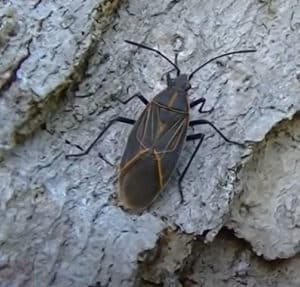Boxelder bugs are a true bug. Adults have black wings and bodies with reddish orange striping and can be between 12mm – 14mm long. Boxelder bugs go through a simple metamorphosis with 5 instar nymphal stages before becoming the black and red adults one might typically see. The first stage instar nymphs will have no wings, but instead have black wing pads and a red abdomen. As they mature, the red coloring on their bodies will continue to darken and they will range in size between 1.3mm – 12mm.
Their natural habitat is in the bark and on the leaves of the Box Elder tree from which they also feed. (They have also been known to feed on certain types of maples as well, making the removal of their habitat an impractical and often ineffective means of control).
People most often become aware of Boxelder bug presence in the fall of the year when the bugs are seeking warmth outside on the south side of homes trees and sheds. Sometimes they will even migrate inside, and if the problem is not addressed properly the homeowner may have trouble with them again in the spring.

Boxelder bugs are not a threat to the structure of a home. They may however swarm around doors and commonly visited outdoor areas of a home and they often give off an odorous plant smell when crushed or killed.
Attempts to seal Boxelder Bugs out of a structure is not very effective. It may help to some extent to prevent them from migrating from the outside of the home to the inside. However, this can be extremely difficult, impractical and often ineffective due to their ability to find and enter the smallest of cracks. This method also will not resolve the nuisances that they cause on the exterior of a home and near common areas around the exterior of a home.
Pesticides are very effective for controlling Boxelder bugs and can be a more effective solution for the exterior of a home than a Proofing/Exclusion and it can also prevent them from migrating inside. A pesticide application’s effect is based upon a broad application of the pesticide to the exterior of a home. This is in many cases is difficult and expensive for a home owner to do on their own due to the lack of equipment and pesticide availability. A licensed pesticide applicator is trained and equipped to perform this task with the most effective pesticide, and will perform it within the legal guidelines for each individual pesticide.
Pesticides do however have certain risks involved. Many of these risks make it more reasonable to have a properly trained and licensed technician/applicator perform the pesticide application because of their training and understanding of all the risks involved both to themselves and those who reside in the home.







